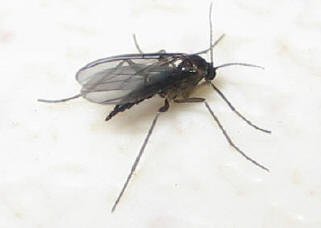(10/27) A recent freeze warning forecast triggered bringing my outside houseplants, cacti and succulents inside for the winter. That act also can bring unwanted hitchhiking pests inside. A few days before coming inside, I usually give them a close examination for visible critters such as aphids or scale that like to hide out under leaves or in leaf-stem intersections.
Any of them having an obvious pest problem get sprayed with a blast of water first for aphids, or as a last resort, with an insecticide labeled for a specific pest such as scale. If spraying an insecticide, always read the label first and do not just grab a "kills all" insecticide. Not all Insecticides treat all pests. Read and follow the label to ensure efficacy.
There is one obnoxious hitchhiker not always visible but who will show up once inside - the fungus soil gnat. These gnats thrive in moist soil and love potted houseplants. You will know you have them when you see very tiny delicate, grayish or black, mosquito-like flies (1/8 inch long) flying around your plants, especially when watering. Fungus gnat larvae usually are
located in the top 2 to 3 inches of the soil, depending on moisture level, and primarily feed on plant roots, fungi, and decaying plant matter.
 Gnats are not strong fliers and emerge from soil when disturbed. Adult fungus gnats actually do not damage plants or bite people. But, the gnatís presence is considered a real nuisance and its larvae are what actually damage a plant. In addition to seeing gnats flying around, plants may exhibit symptoms of
severe infestations such as sudden wilting, loss of vigor, poor growth, and yellowing. Any plant is a target, but African violets, geraniums, and poinsettias are especially prone to attack.
Gnats are not strong fliers and emerge from soil when disturbed. Adult fungus gnats actually do not damage plants or bite people. But, the gnatís presence is considered a real nuisance and its larvae are what actually damage a plant. In addition to seeing gnats flying around, plants may exhibit symptoms of
severe infestations such as sudden wilting, loss of vigor, poor growth, and yellowing. Any plant is a target, but African violets, geraniums, and poinsettias are especially prone to attack.
While fungus gnats can come in from the outside in plants you bring in for the winter, they also hitchhike home in newly purchased plants. Before purchase, turn up soil near the base of a potential new plant and look for glossy larvae or flying gnats. Regardless, it is a good thing to isolate any new plant for a few weeks and especially those coming in from outside.
Adult gnats live about one week and can lay up to 300 eggs in moist potted plant soils. Within
4-6 days tiny larvae emerge and begin feeding on plant roots during their two-weeks as larvae. Their pupal stage lasts 3-4 days then young adults leave the soil and begin the next generation. The entire life cycle from egg to adult may be completed in as little as 3 weeks depending on temperature. Because of this, plants can host each stage: egg, larvae, pupae, and
adult in multiple generations at once.
Treatments aimed at the adults, eggs and larvae require different approaches. Yellow sticky card "traps" are very effective at reducing a flying gnat infestation. These small cards are relatively inexpensive and perch in the plantís pot on a stick. One card is good for a large area and can trap numerous gnats. They are a very good approach to capturing the adults,
particularly adult females, thus reducing the number of larvae in the next generation. I use them all year to monitor for their presence since I have numerous inside plants.
Another strategy to minimize fungus gnat problems is to allow the soil to dry between watering, especially the top 1-2 inches. A drier growing medium can decrease egg and larvae as well as reduce the attractiveness of the soil to egg-laying adult females. Cultivating the top layer of soil to expose eggs and larvae to air also can also be effective.
For severe infestations, contact insecticides can be used on the soilís surface since this is where new adults will emerge. The most effective treatments are those that are persistent for up to several days. Read insecticide labels to determine if they treat fungus gnats. Be sure to follow directions. Insecticides such as those containing soaps, oils, and neem do not
provide sufficient long-term control of gnat adults. Insecticides should be a last resort. It is much easier, and more environmentally friendly to plants inside your house, to let the soil dry and to use yellow sticky traps to catch these unwanted hitchhikers.